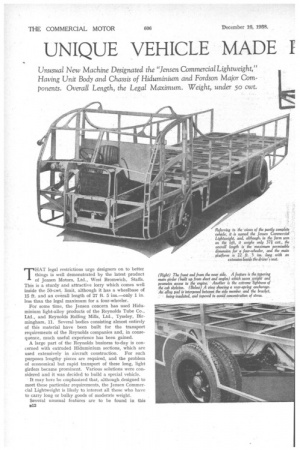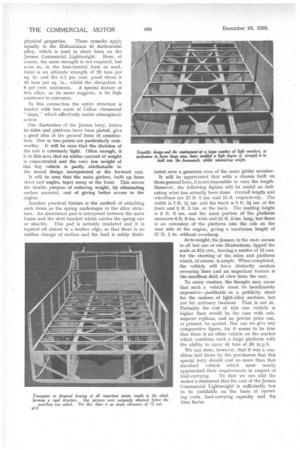UNIQUE VEHICLE MADE )SSIBLE BY LIGHT ALLOYS
Page 46

Page 47

Page 48

If you've noticed an error in this article please click here to report it so we can fix it.
Unusual New Machine Designated the "Jensen Commercial Lightweight," Having Unit Body and Chassis of Hiduminium and Fordson Major Components. Overall Length, the Legal Maximum. Weight, under 50 cwt.
THAT legal restrictions urge designers on to better things is well demonstrated by the latest product of Jensen Motors, Ltd., West Bromwich, Staffs. This is a sturdy and attractive lorry which comes well inside the 50-cwt. limit, although it has a wheelbase of 15 ft. and an overall length of 27 ft. 5 ins.—only 1 in. less than the legal maximum for a four-wheeler.
For some time, the Jensen concern has used Hiduminium light-alloy products of the Reynolds Tube Co., Ltd., and Reynolds Rolling Mills, Ltd., Tyseley, Birmingham, 11. Several bodies consisting almost entirely of this material have been built for the transport requirements of the Reynolds companies and, in consequence, much useful experience has been gained.
A large part of the Reynolds business to-day is concerned with extruded Hiduminium sections, which are used extensively in aircraft construction. For such purposes lengthy pieces are required, and the problem of economical but rapid transport of these long, light girders became prominent. Various solutions were considered and it was decided to build a special vehicle.
It may here be emphasized that, although designed to meet these particular requirements, the Jensen Commercial Lightweight is likely to interest all those who have to carry long or bulky goods of moderate weight.
Several unusual features are to be found in this B12
vehicle, apart from the material used in its construction. Its body and its chassis are virtually one. The material is disposed scientifically and the structure is triangulated extensively. Although it may reasonably be described ag an entirely new vehicle, the mechanical parts are well tried and spares are readily available.
Dealing with the last point first, Fordson components are used. The engine, gearbox, axles, brakes, springs and most of the transmission units are of this make, To suit the unusual length of the chassis, the propeller shaft is, actually, in three pieces. The two rearward parts are standard Fordson products and are accompanied by the usual torque arms forming a triangle with the back axle. Between these and the gearbox, however, there is an additional length of Hardy Spicer propeller shaft, complete with needle-roller universals.
Turning to the main structure, it is noteworthy that standard sections are employed throughout. Apart from such components as bends for the wheel-arches and for some parts of the cab frame, ordinary extruded sections are cut off to the required length and are assembled with rivets and bolts.
Where bolts are used, these are of high-tensile steel and they are cadmium-plated. Mild-steel rivets are employed and these, too, are plated with cadmium. In addition, before they are used, they receive a coating of Bitumastic. These precautions, it has been shown by practical experience, effectively insulate the steel from the aluminium alloy, so that any tendency to electrolytic corrosion is prevented.
Two different alloys are employed. The frame members are of Hiduminium RR 56 and the sheeting used, for example, in the body sides and the floor is of Hicluminium 45 Anticorodal alloy.
The first-named alloy, RR 56, consists principally of aluminium with the admixture of copper, nickel, magnesium. iron, titanium and silicon, in suitable proportions. It was evolved in the Rolls-Royce laboratories and is a product of High Duty Alloys, Ltd., Slough.
In the form of extruded sections, it has an ultimate stress capacity of 27 tons per sq. in., which is comparable with a good mild steel. Its 0.1 per cent, proof stress is 21 tons per sq. in, and its elongation is 10 per cent. These are minimum figures. Its modulus of elasticity is 10,500,000 and the Wohler fatigue figure is 11.2 tons per sq. in. at 20,000,000 reversals. Weight saving is indicated by its specific gravity of 2.75, as compared with approximately 7.8.5 for mild steel.
The foregoing figures apply to the alloy when suitably heat treated, and it is worth mentioning that subsequent temperatures, even as high as that required for stove enamelling (340 degrees F.), do not impair these physical properties. These remarks apply equally to the kliduminium 45 Anticorodal alloy, which is used in sheet form on the Jensen Commercial Lightweight. Here, of course, the same strength is not required, but even so, in the heat-treated, form as used, there is an ultimate strength of 20 tons per sq, in. and the 0.1 per cent. proof stress is 16 tons per sq. in., whilst the elongation is 8 per cent. minimum. A special feature of this alloy, as its name suggests, is its high resistance to corrosion.
In this connection the entire structure is treated with two coats of CeIlon chrornatecl " dope," which effectively resists atmospheric action.
Our illustration of the Jensen lorry, before its sides and platform have been plated, give a good idea of the general form of constrUction. One or two points are parlicnIarly noteworthy. It will be seen that the skeleton of the cab is extremely light. Often enough, it is-in this area that an undue amount of weight is concentrated and the very low weight of this big vehicle is partly attributable to the sound design incorporated at the forward end. It will be seen that the main. girders, built up from sheet and angles, taper away at the front. This serves the double purpose of reducing weight, by eliminating useless material, and of giving better access to the engine.
Another practical feature is the method of attaching such items as the spring anchorages to the alloy struc ture. An aluminium pad is interposed between the main frame and the steel bracket which carries the spring eye or shackle. This pad is suitably insulated and it is tapered ofl almost to a feather edge, so that there is no sudden change of section and the load is safely distri buted over a generous area of the main girder member.
It will be appreciated that with a chassis built on these general lines, it is not impossible to vary the length. However, the following figures will be useful as indicating what has actually been done. Overall length and wheelbase are 27 ft. 5 ins. and 15 ft. respectively. The width is 7 ft. 11 ins, and the track is 5 ft. 3i ins, at the front and 5 ft. 5 ins, at the back. The loading height is 3 ft. 6 ins, and the main portion of the platform measures 6 ft. 9 ins, wide and 22 ft. 3 ins, long, but there is an extension of the platform into the cab on the near side of the engine, giving a maximum length of 27 ft. 1 in, without overhang.
As to weight, the Jensen, in the state shown in all but one of our illustrations, tipped the scale at 37i cwt., leaving a matter of 12 cwt. for the sheeting of the sides and platform which, of course, is ample. When completed, the vehicle will have distinctly modern sweeping lines and an important feature is the excellent field of view from the seat.
To many readers, the thought may occur that such a vehicle must be inordinately expensive—justifiable as a publicity stunt for the makers of light-alloy sections, but not for ordinary business. That is not so. Probably the cost of this one vehicle is higher than would be the case with subsequent replicas, and no precise price can, at present, be quoted. Nor can we give any comparative figure, for it seems to be true that there is no other vehicle on the market which combines such a large platform with the ability to carry 4i tons at 30 m.p.h.
We can state, however, that it was a condition laid down by the purchasers that this special lorry should cost no more than that standard vehicle which most nearly approached their requirements in respect of load-carrying. To that we can add the maker's statement that the cost of the Jensen Commercial Lightweight is sufficiently low to be justifiable on the basis of operating costs, load-carrying capacity and the time factor.




























































































